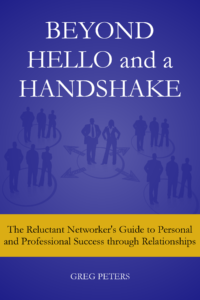 Work continues apace on my next book Beyond Hello and a Handshake. We are looking at possibly second quarter next year for a release (assuming I can stay on track). In the meantime, please enjoy this early draft excerpt from Chapter 2.
Work continues apace on my next book Beyond Hello and a Handshake. We are looking at possibly second quarter next year for a release (assuming I can stay on track). In the meantime, please enjoy this early draft excerpt from Chapter 2.
——————————————
“Trust is the most important part of a relationship, closely followed by communication. I think that if you have those two things, everything else falls into place – your affection, your emotional connection.”
~ Vanessa Lachey
“So now what do I do? I met with them and learned about them. What do I do to connect with them again?”
This is the question I hear from many of the participants in my networking programs. Maybe you run into it, too. You’ve successfully completed your one-to-one with your networking contact. You had a great time chatting with them. What do you do the next time you want to talk with them?
lot depends on what you do in the time after the coffee is cleared. Did you just walk away with a happy glow, believing that an hour with you was enough to fulfill their lives? Or did you take action on what you discovered during that valuable face-to-face time?
n order to build these relationships to the levels you need so that your network becomes a powerful resource for your success, develop a plan for what you are going to do after you part ways. Here is a timeline you can use for after the one-to-one.
- Immediately after. Review your notes or if you didn’t take any (why not?) take a moment to jot down what you can remember. This minute or two now will reduce the frustration later. I can’t tell you how many times in the past I’ve sat down with my notebook even an hour or two after a coffee and had no clue what my cryptic comments were supposed to represent. Take special note of any actions you promised to take on their behalf. Paying attention to these little details are a big part of how you will grow this relationship.
- Within the hour. Respond to immediate promises. Send them the links to materials you recommended (even if they wrote down the information in their notes). Any other action steps that you can do in a few minutes, take care of immediately. Show that you are someone who responds quickly to support them. Even if there were no action steps, this would be a good time to connect via your mutually acceptable social media sites. Whether LinkedIn or Facebook, being connected brings you regular news of their successes and special events.
- Within the day. If you use a CRM (Contact/Customer Relationship Manager), take a few moments to transfer your notes to their entry. It might not seem like much, but the accumulation of these small notes over time will give you the resources for a deeper connection later. The next time you are going to chat with them, it only takes a moment or two to review and remember the kinds of information they don’t put in their LinkedIn profile.
If you want to introduce them to a third party, reach out to that person and ask permission. Most people aren’t going to mind, but your networking partner is more likely to get action if you make the effort to set the stage before the introduction. It also gives you the opportunity to reach out and reconnect with that third person yourself. - In a week or two. Did you make an introduction? Did you send them a resource or pass them a referral? Now is a good time to reach out to them with a quick email to find out what happened. If they have a success, you can celebrate together. If something went awry, you can help make it right or simply learn why it didn’t work out so you can change your own behavior in the future.
- Two to six months. Reconnect. Schedule a coffee or a phone call. Send them more information that might be of use to them. Comment on a blog post that they wrote. The idea is that your first meeting shouldn’t be your last one. If this is an important connection, you’ve got to take the time to maintain it. Don’t overwhelm them, but don’t let them forget you either (in a good way).
Just as when you first met this person, it’s the follow-up that builds the relationship. Creating a system around this helps you stay on track with your connections. You’ve already put time and effort into this relationship. Don’t let that go to waste for lack of a clear plan of how you are going to build the connection to a level that will provide benefit in your life and theirs.

